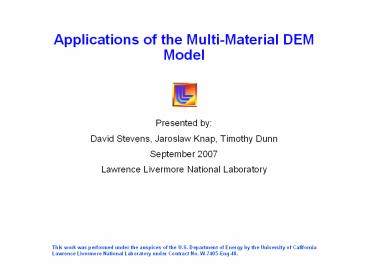Applications of the Multi-Material DEM Model
Title:
Applications of the Multi-Material DEM Model
Description:
Multiphase flow is important in many shock-driven applications ... The Rogue Shock Tube ... Dispersal of Solid Particles', Shock Waves, 11, 431-443, 2001 ... –
Number of Views:28
Avg rating:3.0/5.0
Title: Applications of the Multi-Material DEM Model
1
Applications of the Multi-Material DEM Model
- Presented by
- David Stevens, Jaroslaw Knap, Timothy Dunn
- September 2007
- Lawrence Livermore National Laboratory
This work was performed under the auspices of the
U.S. Department of Energy by the University of
California Lawrence Livermore National Laboratory
under Contract No. W-7405-Eng-48.
2
Introduction
- Multiphase flow is important in many shock-driven
applications - This talk will describe several ways in which we
have adapted the multiphase DEM method of
Chinnayya et al to handle - Complex geometries
- Curvi-Linear coordinates
- Deviatoric strength
- Interface reconstruction
- Adaptive mesh refinement.
3
Multiphase flow model development
- The multiphase model is built upon an Eulerian
treatment of each phase. - This treatment uses a hierarchy of flux-nozzling
pairs defined by the number of waves used in the
numerical solver. - Saurell and Abgrall (1999) are the basis for the
flux-nozzling pairs for the Rusanov (1 wave) and
HLL (2 waves) solvers. - The DEM method of Chinnayya et al. (2003) allows
the use of HLLC.
4
DEM Generalizations
- The following formulation is not limited to the
Euler Equations
Upon Integration by Parts and simplifying
5
Discrete Equation Method
- The most promising model is DEM or Discrete
Equation Method and is based on an acoustic
Riemann Solver. - DEM allows the use of very sophisticated single
phase solvers in a multiphase context. - Flows with deviatoric stresses can easily be
incorporated. - The following results were presented at the
latest International Detonation Symposium in
2006.
6
AUSF
- AUSF (Sun and Takayama, JCP, 2003) is the Riemann
solver used in our version of DEM. - Extends easily to unstructured meshes
- Extends easily to arbitrary equations of state.
Coordinate Rotation and Wave Selection
In 1D this method is identical to HLLC.
7
AUSF Validation
- We have compared AUSF on a number of analytic
planar and spherical test problems
8
The Rogue Shock Tube
- At right is Figure 15 from Experimental and
numerical investigation of the shock-induced
fluidization of a particle bed, Shock Waves, 8,
29-45, 1998. - Numerical results agree well with the
experimental data. - The simulated fluidized bed is slightly ahead of
the experimental observations.
9
Numerical Method Comparison
- Fan Zhang et. al., Explosive Dispersal of Solid
Particles, Shock Waves, 11, 431-443, 2001 has
proven to be a useful data set for model
validation. - DEM appears to best match the experimental data.
10
Reactive Multiphase flows
- Long mixing time scales are often the rate
limiting step for many turbulent reacting flows. - Air and fuel products can compete as oxidizers in
cases when combustion of embedded metals is
present. - Mixing effects on reaction rates
- Pre-initiation
- Enhancement of slower rate reactions
- Extended reaction times
- Long-lived non-reacted fuel parcels.
- These mixing effects require a model for
subgrid-scale heterogeneity.
11
Prescribed PDF Methods for Reactive flows
- Mixture fraction and reaction progress variables
are powerful tools for simplifying reaction
chemistry. - Several widely used closures result from assuming
a prescribed beta PDF for the mixture fraction. - Simple covariance closures
- Flamelet models
- Infinitely fast chemistry
- Binned PDF for use with an equilibrium chemistry
package. - Finite rate kinetics
Beta PDF distribution
12
Infinite Rate Chemistry
- Single Reaction model loosely based on Kuhl,
Howard, and Fried, Proceedings 34th Int.. ICT
conference Energetic Materials Reactions of
Propellants, Explosives, and Pyrotechnics, 2003. - Detonation Products (F) mix with air (A) to
completely combust to product (P).
Figure 4. Le Chatelier diagram for combustion of
TNT explosion products in air.
13
Equilibrium Chemistry
- The mean and varience of the mixture fraction PDF
is tracked in this simulation. - The mixture fraction is defined as 1 inside the
charge and 0 outside. - Only the adiabat for the pure fuel stage at high
energies is needed. - Upon mixing at lower energies, an entire plane of
equilibrium calculations are needed.
Charge Position
4 inch L/D1 TNT cylinder detonation in Air
Equilibrium chemistry calculations as a function
of T,P and Mixture fraction.
14
Adaptive Mesh Refinement (AMR)
- Our approach to AMR combines block structured AMR
and an unstructured local discretization. - The unstructured local discretization handles
reduced and enhanced connectivity in the form of
multi-block meshes with no modification to the
numerics. - Block Structured AMR is used to handle
inter-domain communication via rotations and
translations. All O(n2) operations have been
eliminated. - Zone-centered data for all state variables
dramatically simplifies computer science
requirements.
15
Summary
- We have describes ways in which we have adapted
DEM to incorporate additional physics and
geometrical complexity - turbulent and kinetic effects are being
incorporated by the use of assumed subgrid PDF
methods - Particle size distributions.
- Burned as Mixed model.
- Equilibrium Chemistry.
- Progress variables for finite rate kinetics.
- AMR,
- deviatoric strength
- interface reconstruction.































